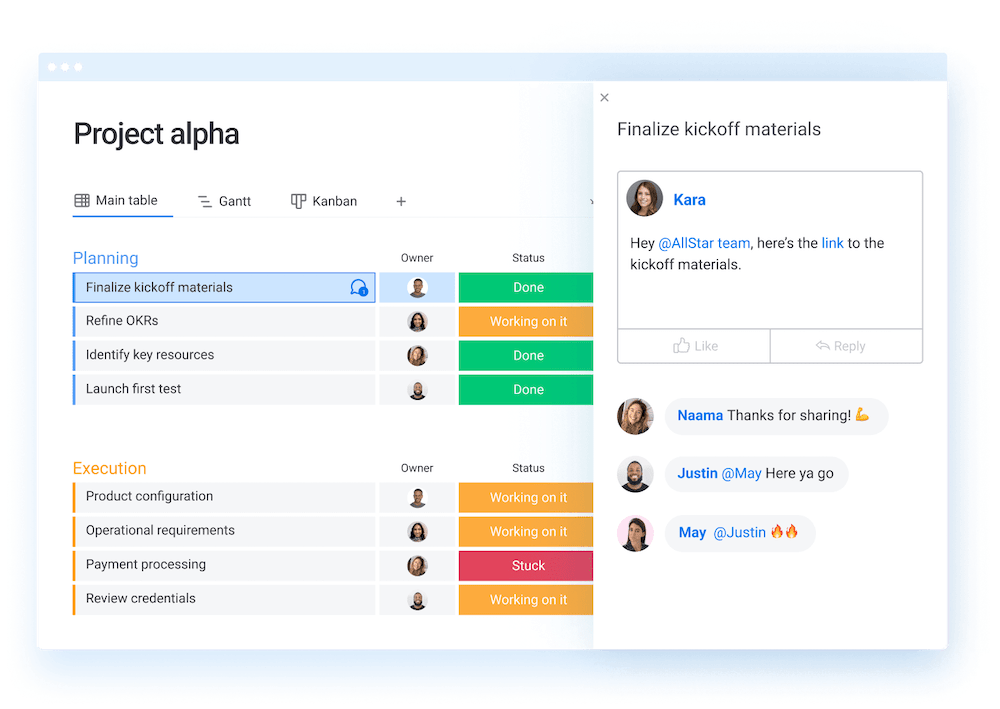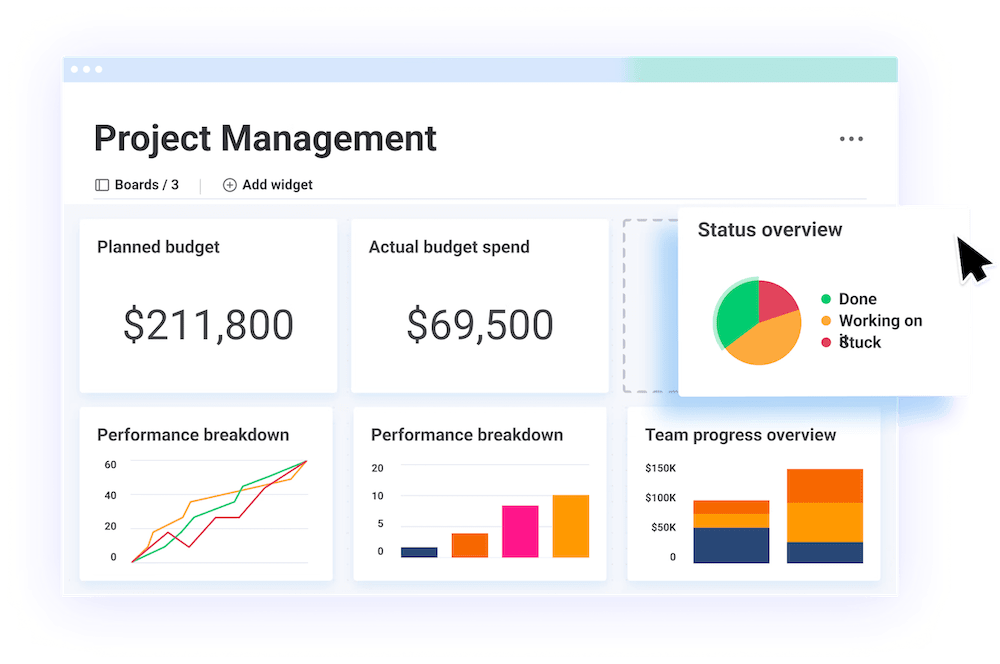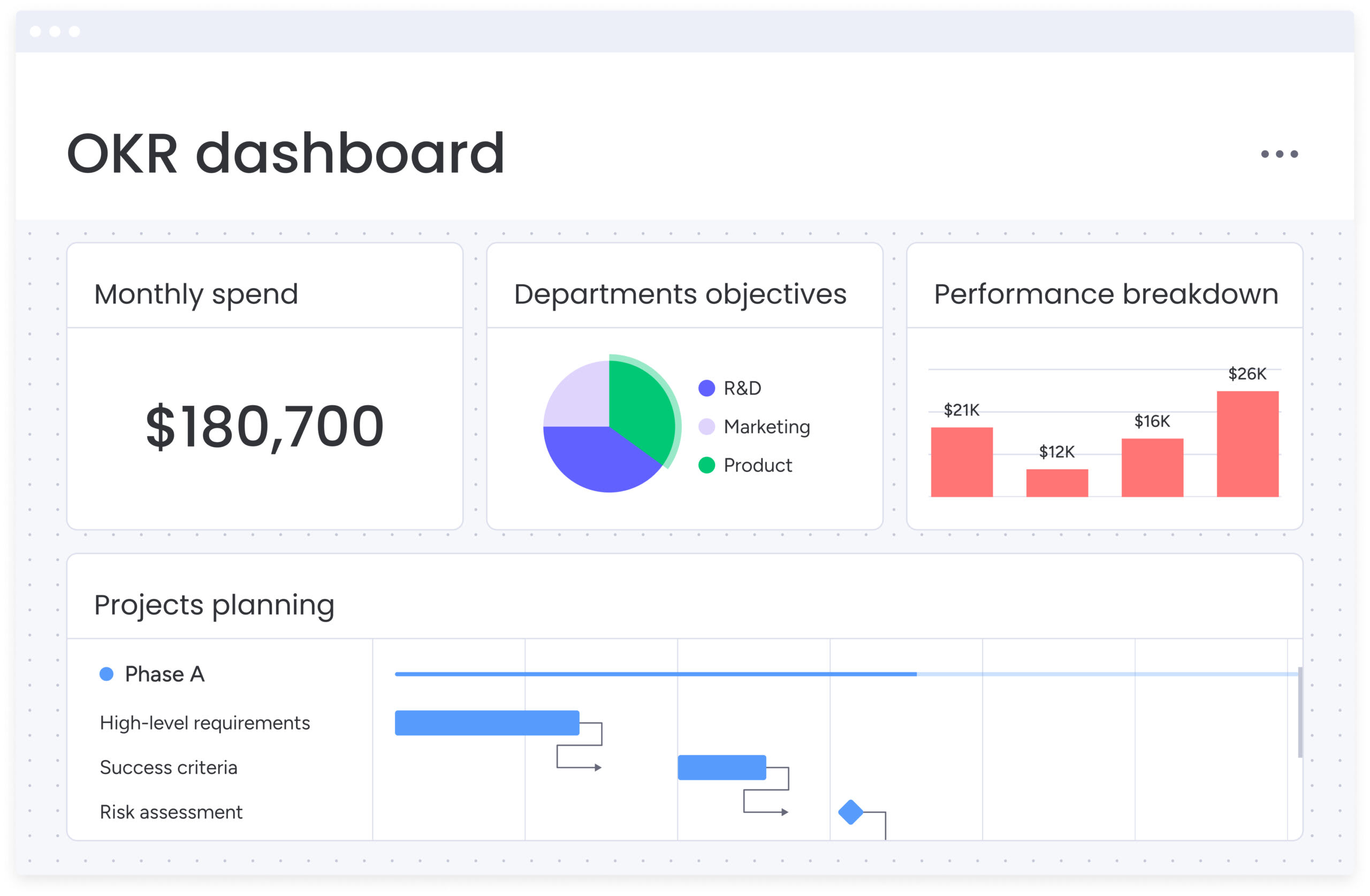Many teams see procurement as a simple purchasing function, a slow but necessary step to get what they need. This view misses the bigger picture where strategic procurement management acts as a powerful engine for business growth, connecting team needs directly to organizational goals.
When procurement operates in a silo, projects stall, budgets become unpredictable, and valuable supplier relationships lack the attention they need to thrive. Bringing this entire process into a central workspace like monday work management helps align purchasing activities with broader business objectives, turning scattered requests into a streamlined, visible pipeline.
This guide walks through the fundamentals of effective procurement. We will cover the seven key steps in the process, define essential roles and responsibilities, and show you how to integrate procurement into your overall strategy for faster, more confident execution.
What procurement management means
Procurement management is the strategic process organizations use to acquire goods, services, and resources from external suppliers to meet operational needs efficiently and cost-effectively. This procurement management definition encompasses everything from identifying what to buy and when to buy it, to managing ongoing supplier relationships and ensuring contract compliance.
To define procurement management more specifically, it involves strategic planning, market analysis, supplier evaluation, contract negotiation, and performance monitoring. The meaning of procurement management extends beyond simple purchasing transactions to include comprehensive supplier relationship management and risk mitigation strategies.
What is procurement differs from basic purchasing because it focuses on long-term value creation rather than individual transactions. When organizations explain procurement management to stakeholders, they emphasize its role in controlling costs, ensuring quality, and maintaining business continuity through strategic supplier partnerships.
Why it matters for organizations
Effective procurement management directly impacts financial performance, operational resilience, and competitive positioning. Strategic procurement practices enable organizations to optimize spending while improving quality and delivery reliability across their supply chains.
Supply chain disruptions have highlighted the critical importance of diversified supplier networks and strong vendor relationships. Organizations with robust procurement management processes can pivot quickly when primary suppliers face challenges, maintaining business continuity while competitors struggle with shortages or delays.
The benefits of procurement process implementation include access to innovation and emerging technologies through strategic supplier partnerships. How effectively does your organization leverage supplier expertise to drive competitive advantage? Companies that view procurement as a strategic function often discover new capabilities and market opportunities through their vendor ecosystem.
7 steps in the procurement management process
The procurement management process follows a systematic approach that ensures organizations acquire the right goods and services at optimal value. Understanding this structured procurement management process helps teams avoid common pitfalls like rushed vendor selection or inadequate requirement definition.
Each step in the procurement process builds upon the previous one to create a comprehensive framework for strategic sourcing and supplier management. monday work management enables teams to track each phase of this process through customizable workflows and automated notifications.
Step 1: Identify business needs
Organizations must first understand what they need to procure, when they need it, and why it’s necessary. This involves conducting thorough needs assessments and consulting with stakeholders across departments to gather detailed requirements that align with business objectives.
Effective needs identification requires collaboration between requesting departments, procurement teams, and budget owners. Teams should document not just what they want to buy, but the underlying business problem they’re trying to solve.

Step 2: Develop clear requirements
Transform business needs into specific, measurable requirements including technical specifications, quality standards, delivery timelines, and budget parameters. Clear documentation prevents misunderstandings and ensures suppliers can provide accurate proposals.
Requirements should include both functional specifications and performance criteria. Consider factors like scalability, integration capabilities, support requirements, and total cost of ownership rather than just initial purchase price.
Step 3: Conduct supplier research
Perform comprehensive market research to identify potential suppliers and conduct preliminary evaluations. Assess supplier capabilities, financial stability, reputation, and cultural fit with your organization’s values and working style.
This research phase should include reviewing supplier certifications, checking references, and evaluating their track record with similar projects. Create detailed supplier profiles that capture both quantitative metrics and qualitative assessments.
Step 4: Evaluate and select vendors
Use a formal evaluation process that includes developing requests for proposals (RFPs), reviewing supplier responses, and conducting thorough assessments. Evaluate suppliers based on multiple criteria including cost, quality, delivery capability, technical expertise, and strategic alignment.
Establish clear scoring criteria before beginning the evaluation process to ensure objective decision-making. Consider conducting supplier presentations or site visits for high-value or strategic purchases.
Step 5: Negotiate and finalize contracts
Negotiate contract terms that protect your organization’s interests while establishing fair and sustainable relationships with suppliers. Focus on pricing, service levels, delivery terms, quality standards, and risk allocation.
Contract negotiation should address not just initial terms but also change management processes, performance monitoring requirements, and dispute resolution mechanisms. Ensure contracts include clear exit clauses and intellectual property protections where relevant.
Step 6: Manage and monitor supplier performance
Implement ongoing supplier relationship management including regular performance reviews, issue resolution processes, and continuous improvement initiatives. Use key performance indicators (KPIs) to track delivery, quality, and service levels.
Regular supplier meetings and performance dashboards help identify potential issues before they impact operations. Establish escalation procedures for addressing performance gaps and recognize suppliers who exceed expectations.
Step 7: Close out and review lessons
Complete contract closeouts, conduct final evaluations, and capture insights for future procurement activities. Document what worked well and what could be improved to enhance future procurement processes.
This review phase should include feedback from all stakeholders involved in the procurement process. Use these insights to refine procurement procedures and supplier selection criteria for similar future purchases.
Try monday work managementKey roles and responsibilities
Successful procurement management requires clear role definition and collaborative engagement across multiple stakeholders. Understanding who contributes what ensures accountability and prevents gaps in the procurement process.
The complexity of modern procurement means no single person can handle every aspect effectively. Different roles bring specialized expertise that collectively drives optimal outcomes for procurement and management initiatives.
Procurement managers and teams
Procurement managers serve as the strategic orchestrators of the entire process, bringing market knowledge, negotiation expertise, and process discipline to ensure organizations achieve optimal value from their supplier relationships. These specialists handle strategic sourcing, supplier relationship management, contract negotiation, and compliance oversight.
They understand market dynamics, pricing trends, and risk factors that influence procurement decisions. Procurement managers also maintain supplier databases, track performance metrics, and identify opportunities for cost savings or process improvements.
Stakeholders and approvers
Internal stakeholders include department heads who define requirements, finance teams who manage budgets, legal counsel who review contracts, and executive leadership who make final decisions on strategic purchases. Each stakeholder group brings essential perspectives to the procurement process.
Technical teams understand functional requirements, while finance ensures budget alignment and legal teams protect against contractual risks. Executive sponsors provide strategic direction and final approval authority for significant purchases.
External suppliers and vendors
Suppliers play an active role in successful procurement by developing competitive proposals, providing technical expertise, and delivering goods or services according to agreed specifications. The most effective supplier relationships involve collaborative problem-solving and continuous improvement.
Suppliers often bring industry insights and innovative solutions that internal teams might not consider. Strong supplier partnerships can become competitive advantages through preferential pricing, priority support, or early access to new capabilities.
Integrating procurement with overall work management
Procurement activities must integrate seamlessly with broader organizational workflows and business processes to ensure procurement decisions support overall business objectives. This integration ensures procurement enhances rather than hinders organizational agility.
Modern organizations recognize that procurement impacts project timelines, budget management, risk profiles, and cross-departmental collaboration — and the World of Work Report shows that 82% of employees already rely on work/project management software to keep these touchpoints aligned. How well does your procurement process align with project delivery schedules and strategic initiatives?
Management and procurement integration connects directly to project management through delivery timelines and milestone dependencies. Budget planning requires procurement input for accurate cost forecasting and resource allocation, while risk management must consider supplier-related risks alongside other business factors.
monday work management provides centralized visibility across these connected processes, enabling teams to see how procurement decisions impact broader business objectives. The platform’s customizable workflows support procurement approval processes while automated notifications keep stakeholders informed of progress and potential delays.
Real-time dashboards help procurement teams track multiple sourcing activities simultaneously while providing executives with high-level visibility into procurement pipeline and spending patterns. This integration eliminates information silos and ensures procurement supports organizational agility.
Project procurement management essentials
What is procurement management in project management involves specialized approaches that align supplier selection and contract terms with project objectives, timelines, and success criteria. Unlike operational procurement, project procurement often involves unique requirements and compressed timelines.
Successful project procurement demands early planning and close coordination between project managers and procurement teams. What procurement activities could delay your project if not properly planned?
Aligning procurement with project goals
Project procurement must support specific project objectives, quality standards, and delivery schedules. This alignment requires procurement teams to understand project scope, critical path activities, and success metrics.
Early procurement planning helps identify long-lead-time items that could impact project schedules. Project managers should involve procurement specialists during project planning to ensure realistic timelines and budget estimates.
Coordinating schedules and deliverables
Procurement timelines must integrate with project schedules, including supplier lead times, delivery coordination, and milestone alignment. This coordination prevents procurement delays from becoming project bottlenecks.
Effective schedule coordination requires clear communication between procurement teams, project managers, and suppliers. Regular status updates and proactive issue escalation help maintain project momentum when procurement challenges arise.
Try monday work managementTop procurement management systems and platforms
Technology solutions play an increasingly important role in modern procurement management by automating routine processes, providing spend visibility, and enabling data-driven decision-making. The right technology stack can transform procurement from a reactive, paper-based process into a strategic, data-driven function.
Organizations should evaluate procurement management software based on their specific needs, existing systems, and growth plans. These procurement management systems provide the foundation for scaling procurement operations while maintaining control and visibility.
E-procurement platforms
Digital procurement solutions automate sourcing workflows, supplier onboarding, and contract management processes. These platforms typically include supplier portals, electronic bidding capabilities, and automated approval workflows.
E-procurement platforms reduce processing time, improve compliance, and provide audit trails for procurement activities. They often integrate with financial systems to streamline purchase-to-pay processes and provide real-time spending visibility.
Work management and collaboration platforms
Modern work management platforms support procurement through customizable workflows, automated approvals, and cross-team collaboration capabilities. These platforms excel at managing the human elements of procurement that traditional e-procurement systems often overlook.
monday work management enables procurement teams to create custom workflows for different types of purchases, automate approval routing based on dollar thresholds, and provide real-time visibility into procurement pipeline status. The platform’s AI capabilities can categorize suppliers, extract key information from contracts, and automate routine procurement tasks — capabilities that align with findings from the World of Work Report, which notes that 86% of IT professionals already use AI in their day-to-day work.
Collaboration features help procurement teams coordinate with stakeholders, track supplier communications, and manage complex multi-stakeholder approval processes. Customizable dashboards provide executives with real-time insights into procurement KPIs and spending patterns.
How to plan and optimize procurement control
Effective procurement control requires governance frameworks, compliance monitoring, and optimization strategies that balance cost management with operational flexibility. Organizations must establish clear policies while maintaining agility to respond to changing business needs.
Strong procurement control protects against fraud, ensures regulatory compliance, and optimizes spending patterns. However, overly rigid controls can slow decision-making and frustrate stakeholders who need procurement support.
Planning for budget and compliance
To plan procurement management effectively, allocate budgets based on historical spending patterns, anticipated business needs, and strategic initiatives. Implement spending controls that prevent unauthorized purchases while enabling legitimate business requirements.
Budget planning should include contingency reserves for unexpected procurement needs and market price fluctuations. Regular budget reviews help identify spending trends and optimization opportunities while ensuring compliance with regulatory requirements.

Implementing clear policies
Standardized procurement policies provide consistency while reducing training requirements and decision-making complexity. Policies should cover supplier selection criteria, approval workflows, contract terms, and performance management requirements.
Clear policies help stakeholders understand their roles and responsibilities while providing procurement teams with authority to enforce standards. Regular policy updates ensure procedures remain relevant as business needs evolve.
Monitoring with dashboards
Real-time visibility into procurement activities helps track spending patterns, monitor supplier performance, and identify optimization opportunities. Dashboard capabilities should provide both operational metrics and strategic insights for effective purchasing management.
monday work management’s dashboard features enable procurement teams to create customized views that track key metrics like procurement cycle times, supplier performance scores, and budget utilization. These dashboards can be shared with stakeholders to provide transparency and support data-driven decision-making.

Streamlined purchasing through managed procurement services
Organizations increasingly consider procurement management services to access specialized expertise, reduce costs, and improve operational efficiency. This approach can be particularly valuable for non-core procurement categories or organizations lacking internal procurement expertise.
Managed procurement services range from full outsourcing of procurement functions to specialized support for specific categories or processes. The key is finding the right balance between internal control and external expertise for optimal services procurement management.
Benefits of managed procurement include access to specialized market knowledge, economies of scale through aggregated purchasing power, and reduced internal resource requirements. Service providers often bring advanced technology platforms and established supplier relationships that would be costly for individual organizations to develop.
Technology platforms can support both in-house and managed procurement models by providing visibility, control, and collaboration capabilities regardless of who performs the actual procurement activities. This flexibility enables organizations to optimize their procurement operating model based on changing business needs.
Try monday work managementNext steps for effective procurement management
Transforming procurement into a strategic business driver goes beyond simply automating purchases — it requires commitment to process improvement, technology adoption, and cross-team collaboration. Here’s how to get started:
- Assess your current procurement maturity: Evaluate existing processes against industry best practices to pinpoint gaps in technology, skills, or procedures that may limit effectiveness.
- Prioritize improvements: Develop a clear roadmap that focuses on initiatives with the highest potential impact, from workflow automation to skills training or policy refinement.
- Secure executive sponsorship and stakeholder buy-in: Successful transformation relies on leadership support and collaboration across departments to ensure alignment and resource availability.
- Start with pilot programs: Launch targeted initiatives that demonstrate value quickly, then scale these improvements organization-wide as lessons are learned.
- Leverage technology for efficiency and visibility: Platforms like monday work management offer customizable workflows, real-time dashboards, and automation to centralize procurement activities and accelerate progress as your team’s procurement maturity grows.
Give monday work management a try as your procurement software, and build scalable, strategic procurement workflows that move your organization forward
Frequently asked questions about procurement management
What is procurement management in simple terms?
Procurement management is the strategic process organizations use to acquire goods and services from external suppliers efficiently and cost-effectively. It includes planning what to buy, selecting suppliers, negotiating contracts, and managing ongoing supplier relationships to meet business needs.
What are the 7 stages of procurement management?
The 7 stages of procurement management are: identify business needs, develop clear requirements, conduct supplier research, evaluate and select vendors, negotiate and finalize contracts, manage and monitor supplier performance, and close out with lessons learned review.
What does a procurement manager do daily?
A procurement manager oversees strategic sourcing activities, manages supplier relationships, negotiates contracts, monitors supplier performance, ensures compliance with procurement policies, and collaborates with internal stakeholders to meet organizational purchasing needs.
What are the three main types of procurement?
The three main types of procurement are direct procurement (materials that become part of finished products), indirect procurement (goods and services that support operations like office supplies and software), and services procurement (professional services, consulting, and outsourced functions).
How does procurement management reduce business costs?
Procurement management reduces costs through strategic sourcing, bulk purchasing negotiations, supplier performance optimization, and spend visibility that identifies savings opportunities. Organizations achieve cost reductions through competitive bidding, contract consolidation, and elimination of maverick spending.
What is the difference between procurement and purchasing?
Procurement is a strategic, end-to-end process that includes planning, sourcing, supplier relationship management, and performance monitoring, while purchasing is simply the transactional act of buying goods or services. Procurement focuses on long-term value creation rather than individual transactions.

